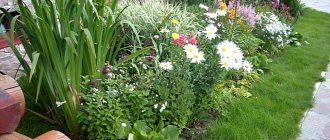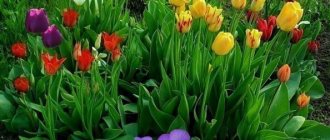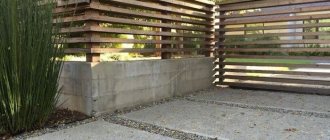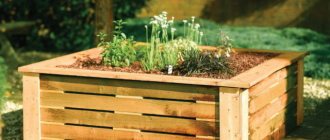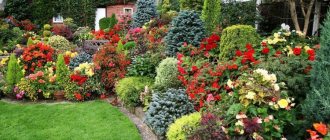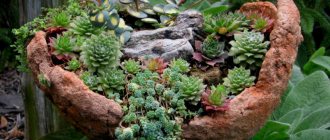Grow seedlings, bring them, plant them, pinch them - and all this so that the plant has time to please you for one season? It is not surprising that many gardeners prefer to think three times before planting annuals in their flower garden. And yet you shouldn’t completely discount such plants.
Most often, annuals are planted in order to refresh the composition with plants that have been decorating the site for more than one year. However, few people decide to arrange a flowerbed on their site that would consist of 100% annuals.
Meanwhile, it is precisely these flower beds that will be an excellent solution for summer residents who do not yet have a clear idea of what they would like to see on their site in the end. It wouldn’t hurt to pay attention to a flowerbed consisting only of annual plants for those gardeners who do not like monotony and are therefore in a constant state of creative search.
Using annuals, you can “try on” one or another color scheme in order to decide on the most suitable varieties. We should not forget that annuals, although they require some attention during the period of sowing and growing seedlings, usually do not cause any trouble during the season.
- 10 most irreplaceable annuals
Be sure to plant these unpretentious flowers in your garden!
Lobularia maritima
Lobularia belongs to that rare category of plants that can delight with their abundant flowering almost until the cold weather. If you want the plant to bloom at the very beginning of summer, then you will have to start planting seeds for seedlings at the end of March or beginning of April. When the threat of frost has passed, the seedlings can be planted in open ground.
Lobularia is watered only in very hot and dry summers. In order for the plant to bloom again, closer to August, when the first wave of flowering comes to an end, the lobularia will need to undergo “radical” pruning. Very soon the plant will grow back the lost green mass and bloom again.
The original scheme uses the Pastel Carpet variety.
- What to sow in March for seedlings
What kind of seeds have the containers and soil specially stored for them already been waiting for?
Flowers make you think
And over time, I finally managed to make, create, create with my own hands a real flower fairy tale. And now the multi-colored miracle pleases the eye not only with its curly realism, but also with some encrypted meaning, a sign.
After all, let’s say that the highly respected annual asters are a symbol of intelligent girls, for they are philosophical and thoughtful flowers. But annual dahlias, on the contrary, are for eccentric and frivolous people. Cute burgundy-orange marigolds, as if wanting to say: “Even though I’m a little jealous, I still trust.”
Gomphrena globose
Gomphrena is a low (up to 40 cm) annual with spherical inflorescences and bluish foliage. Gardeners value this culture because even at the very end of autumn, gomphrena flowers continue to remain decorative. Even after cutting, this plant retains its attractive shape, which makes it especially valuable in the eyes of those who like to decorate their home with bouquets of dried flowers.
In the climatic conditions of the middle zone, gomphrena is grown exclusively by seedlings, because when sowing in open ground, there is a possibility that the seedlings simply will not sprout. The plant is sown for seedlings in early March, and planted in open ground in May, when the threat of return frosts has passed.
The original flower garden uses the Bicolor Rose variety.
- Flowers for winter bouquets: which ones to choose, when to cut, how to dry
These dried flower plants are ideal for decorating the garden from spring to late autumn, as well as for creating winter bouquets.
The benefits of real flowers
In addition to purely aesthetic pleasure and pleasure, annual flowers for the garden can also bring real practical benefits to the entire garden. In particular, their wonderful aroma and “scorching” color of some annuals attract pollinating insects to the dacha as much as possible. At the same time, the smell of other similar flowers, on the contrary, repels pests that are dangerous to the garden and beds.
Thus, for purely practical purposes, marigolds are successfully used, which have a specific aroma that protects against harmful insects. That’s why they are often planted close to areas where potatoes are planted. So that they repel both the Colorado potato beetle and various types of tuber pests.
Ground cover (creeping) perennials blooming all summer: types, names, photos, description. TOP 10 best options for a summer residenceClematis flowers - 70 photos of a beautiful flower. Planting, growing and care in open ground
Astilbe: planting, care. growing from seeds, photos, description of species
Moreover, a number of annual flowers have remarkable healing properties that can fight many human ailments. For example, tea made from cornflower and calendula thoroughly tones the body and gives strength to the patient. In turn, tincture of calendula flowers is a classic remedy for combating throat diseases.
Salvia sparkling (salvia brilliantus)
In its natural habitat, sparkling salvia grows in the same place for many years, but in the middle zone it is grown exclusively as an annual. Salvia blooms from June until frost.
The seeds of this plant are sown for seedlings in mid-February or early March. However, they do this not in order to get earlier flowering, but in order to plant seedlings in place of already faded spring bulbs. It requires almost no watering. It loves sunny places and does not react well to stagnant moisture, so it is recommended to loosen the plant after rains.
The original flower garden uses the Blue Wonder variety.
- Spring bulbs - photos, names, tips for planting and growing
A selection of 20 spring-flowering bulbs with photos, descriptions and planting tips.
Principles for creating a flower bed from annuals
Before you start arranging a flower garden, you need to choose a suitable place (most annual plants love sunlight very much), think over the shape of the flower bed (the most common flower beds are in the form of geometric shapes), select annual flower bed plants that match the color scheme, and plan the placement of the plants.
Do not forget about the simple rules for creating various flower beds:
- Tall plants should be placed in the background or in the center of the flower bed.
- As you approach the edges of the flower garden, the height of the plants should decrease proportionately. It is not recommended to allow large differences in flower sizes.
- In the foreground, a small border of low-growing flowers will look more beautiful and neat.
- The planting density of plants in a flower bed increases with decreasing height of the plants used.
Marigold
Marigolds are frequent guests of flower beds in the middle zone. The bright yellow and deep orange caps of these plants delight with their flowering from the beginning of summer until almost frost. When you get ready to prepare the flowerbed for winter, the marigolds can be planted in the ground by burying them with shovels on a bayonet. The only drawback of marigolds is their somewhat specific smell, which not everyone likes.
There are a huge number of varieties of this crop. For our scheme, yellow-flowered varieties from the Calando or Luxor series are best suited. The original version used the Lemon Drop variety.
- Instructions: growing marigold seedlings at home
Do you want a bright and sunny flowerbed in the summer? Or maybe you dream of a small garden in hanging boxes right on the balcony? Then sow marigolds!
Let's look at the catalog
Of course, for every summer resident, his dacha is his own little “paradise on earth,” where, perhaps, there are marvelous flower beds, alpine slides, and even paved paths with fountains. Therefore, it is quite logical that one would like to decorate such wonderful landscapes in a truly, dignified and bright way. As they say, with taste.
Pelargonium in open ground: planting, growing, care, reproduction, photoDahlia flowers: planting and care in open ground. Photos, instructions, types, varieties, reviews
Marigolds: planting, growing, care and propagation in open ground. Overview of all types and varieties of marigold flowers
But to do this, you need to clearly imagine what you will have to decorate your dacha area with. Therefore, you should know not only the names of annual flowers, but also their biological characteristics.
And it is for these purposes that he should look into the catalog of annual flowers, where he will find all the most complete and necessary information for the quality arrangement of his flower garden. It is in such collections that you can learn about varieties, biological characteristics, and price ranges for this or that flower product. Moreover, thanks to this newsletter, you can easily order and soon receive the annual flower seeds you are interested in.
Catharanthus
A close relative of the well-known periwinkle, catharanthus, belongs to the category of plants that can survive without watering for a very long time. Unlike many other annuals, catharanthus can be sown directly into open ground. And yet, most often this crop is grown through seedlings, since the plant blooms only 2-2.5 months after sowing the seeds. Catharanthus seedlings are sown in late February or early March, and planting in open ground is planned for late May or early June.
Blooming all summer
Flowers that bloom throughout the summer are a great option for creating a beautiful, colorful flower bed. Flowers that bloom for a long time can be of any type, so you should select them very carefully.
Among the low-growing flowers for the flower bed, those that bloom all summer are best suited:
- purslane - blooms until the first frost;
- periwinkle - does not require special care and frequent watering;
- night violet - grows quite quickly;
Other flowers include aster, dahlia, and delphinium.
Snapdragon
One of the most popular annuals grown in midland gardens. Its flowers collected in large inflorescences-tassels can decorate any garden. There are a large number of varieties of this plant, but if you are going to implement our particular scheme, first of all you will have to pay attention to low-growing varieties with orange or salmon-colored flowers, for example, Twinnie or Bronze Ring F1.
Snapdragon blooms profusely and for a long time - from June to October. It is undemanding in care and almost does not react to temperature changes.
- Snapdragon: growing from seeds, planting and care in open ground
Step-by-step instructions with valuable tips.
Petunia
Petunia is one of the most popular annuals grown in midland gardens. Prefers loamy and sandy soils, but can grow in any fertile soil.
If you are looking for some unusual petunia variety for your garden, pay attention to plants with double or bicolor flowers. However, do not forget that most often varietal specimens are propagated not by seeds obtained from the parent plant, but by cuttings. Only in this case will you receive planting material that has retained all the qualities of the mother plant.
- How to grow petunia seedlings at home - step-by-step master class with photos
Everything about growing petunias: from sowing to pinching.
Morning glory tricolor
Morning glory is a vine with heart-shaped leaves and 4-9 cm funnel-shaped flowers. The color of the petals varies from pale blue to deep blue. The center of the flower can be either white or yellowish, depending on the variety.
The main distinguishing feature of this flower is its ability to open and close its petals in different light conditions. In the morning the flowers open, and in the evening or in cloudy weather they close. It is curious that on sunny days the vine's stalks turn after the sun.
If you are faced with the task of creating a flowerbed in an open space, but you are afraid that being in direct sunlight could be fatal for your plants, be sure to check out our annual flowerbed diagram.
Prepared based on materials from the website www.bhg.com
What annual flowers bloom all summer. Catalog of plants with photos and names
Beautiful flowers in original and well-kept flower beds will always delight the eyes of others and give them positive emotions. Annual plants that bloom throughout the summer will give you their beauty with the first rays of spring before the onset of cold weather. In this article we will list annual unpretentious flowers for the garden. Here you can see their photos with names. There is also a catalog here. The desire to turn your garden plot into a small island of paradise is inherent in all people. And this can be done. In addition, you can try to design your own garden so that it can look different every year. Annual flowers will help you create new compositions every year.
Content
Flowerbed with annual flowers
Annual flowers have many advantages. You won't have to worry about how they will survive the winter. You can plan their location on your summer cottage in advance. By correctly combining the shades of plants and the flowering time of their individual species, you can get an excellent result - flower beds that will play with bright colors in the sun throughout the summer. Many annuals love sunny areas. But there are also species that prefer shade.
Annuals for flower beds
Annual flowers that bloom all summer without seedlings are an excellent opportunity to decorate your garden plot. Remember the name and photo of such plants. As a rule, annuals undergo a complete vegetation cycle in one summer period. They begin to develop and bloom quite quickly. The most unpretentious annual flowers for a flower bed, which will bloom all summer, are marigolds, petunias, sage, nasturtium, and calendula. As a rule, flower beds have one shape and specified boundaries: round, diamond-shaped, rectangular. In most cases, flowers in a flowerbed are located in the same plane. But there are also raised, multi-tiered and vertical options. In these areas, low-growing annuals will look very impressive. As a rule, they are planted singly or next to tall flowers. They mainly act as ground covers, filling empty areas, for example, between roses or other biting plants.
Annual marigolds Karina.
Marigolds differ from other flowers by long flowering and have a yellow-orange color with brown tints. They are quite unpretentious flowers. They grow well in sunny places, but also love shade.
Petunia.
The beautiful petunia has many bright colors. Likes to grow in sunny areas. Petunia prefers warmth. Its flowering continues all summer. But with the first cold weather it practically stops growing.
Blue salvia.
From this article you can learn about which annual flowers bloom all summer. Salvia is an unpretentious annual plant that can be combined well with other flowers. Salvia inflorescences resemble the shape of a candle. The color range of their shades is very diverse. But candles in pink, purple, lilac, and red shades look much more impressive in flower beds.
Calendula.
Calendula with orange or yellow lush flowers stands out among other plants as a beautiful spot. In addition to its decorative properties, calendula has medicinal properties. And its leaves and flowers are used in cooking.
Nasturtium.
Nasturtium has many varieties. Its terry species are very beautiful. Nasturtium prefers the sun, a lot of light, but also feels good in the shade. But in such a place this plant will produce more foliage, but not inflorescences. Nasturtium flowers are red, bright orange and yellow.
Snapdragon.
Annual plants that bloom throughout the summer season are Snapdragons. This flower attracts many with its very original shape and combination of colors (yellow, white with pink, or just pink or white lily). Annual snapdragon will look great next to other plants.
Zinnia.
Unpretentious annual flowers that bloom all summer can perfectly decorate a summer cottage of any size. And here we list only the best varieties of flowers for flower beds. If you plant zinnia in your garden plot, you will admire its long flowering for a long time. One inflorescence can bloom for up to 40 days. Zinnia is an annual. Even if you cut the zinnia, it will stay in the vase for quite a long time and will not wilt. The more fertile the soil in the flower garden, the brighter the inflorescences will be. They can be both tall and short. Zinnia flowers can be variegated or plain. The plant prefers warmth and sun.
Calceolaria.
Calceolaria is another plant with an original form.
Dimorphothecia.
Bud dimorphothecium is very simple in appearance. But this is precisely where their beauty lies. The flowers resemble chamomile in shape. The height of the stem is approximately 30 cm. The color palette of dimorphotheca is very diverse - orange, purple, pink, white. The petals have a double color. This annual blooms for a very long time and is unpretentious. Not afraid of various diseases and pests.
Lobelia.
Lobelia is another quite popular flower loved by many gardeners. It has a beautiful and wide range of colors. Its delicate purple, white, blue, lilac and blue bushes look great in flower beds, along garden paths and in hanging containers. This unpretentious annual prefers moisture and light.
Nemophila.
Nemophila or American forget-me-not is not widespread in our country. It requires constant feeding. It differs in that it can bloom in rainy weather. Nemophila has a pleasant and subtle aroma. Looks beautiful in flower beds because of its delicate color. It can be white-blue, white, purple. There are varieties of nemophila that have dark purple or black inflorescences.
Coreopsis.
In this article we list annual flowers that bloom all summer and will grow without seedlings. Coreopsis is an annual plant whose flowers are smaller in size and height than their perennial counterparts. This plant has a long flowering period. Feels great in flowerpots, flower beds, and near borders. In general, anywhere. It fits in superbly.
Brachycoma.
Brachycoma is a bushy annual that comes in beautiful shades of lilac and purple. An unpretentious flower. But still, it will feel best on sandy and fertile soil. Loves warmth and sun.
Dahlias.
Plants such as dahlias are unpretentious annuals. Dwarf, low-growing varieties of dahlia are perfect for flower beds and borders. Dahlia inflorescences are very bright.
Mattiola.
Mattiola - night violet Because of its wonderful aroma, you should plant Mattiola or night violet in your garden. Mattiola has about twenty different varieties. The inflorescences of this plant are dense, small, pink, soft lilac and dark purple. In addition to these flowers, there are pale yellow and white inflorescences. This annual plant is unpretentious, easy to care for, prefers sunny places, but also can grow in partial shade. Mathiolla is a low plant that can bloom all summer.
Garden annual balsam.
Impatiens differs from other annuals in its height (60-70cm) and large inflorescences. They come in terry and semi-double. Impatiens have a variety of colors: scarlet, white, pink and crimson.
Datura or Datura.
Datura, a plant with large inflorescences, can truly decorate your garden with beautiful white flowers that resemble the shape of a bell. There are also blue, red and yellow varieties. Datura develops quickly and differs from other annuals by its long and abundant flowering. Datura is a tall flower (from a meter and above).
Mallow is annual.
Annual mallow is distinguished by its beauty and size (from 40 to 120 cm). Has double inflorescences. Mallow is unpretentious in its care. Drought resistant.
Cornflower.
Beautiful cornflower blooms from late May to September. It is an unpretentious annual with medium height and small, dense flowers in pink, bright blue, white and purple. It will look original in mixed flower beds.
Bell.
The annual bluebell is a low-growing flower with light blue inflorescences. It prefers sunny areas, but will also grow well in partial shade. But it will not bloom very profusely in such a place. The bluebell blooms throughout the summer.
Iberis snow-white.
Snow-white Iberis is the shortest annual plant (up to 25-30cm). Loves a lot of sun. Does well in partial shade.
Shade-loving annuals
For problem areas - under the lush crowns of spreading trees or lush shrubs, unpretentious annual plants that like to grow in the shade are best suited. These flowers have dense foliage. Such plants will not bloom as profusely as sun-loving flowers.
Cosmea.
Beautiful bright cosmos are shade-loving flowers for flower beds. They can create a festive atmosphere even in shaded areas of your garden. Cosmea blooms for a very long time and abundantly. Their shape resembles that of an ordinary chamomile. Cosmea's color palette has raspberry and pink shades. White cosmos will be able to revive shaded areas.
annual unpretentious flowers for the garden photos with names catalog
Plants such as forget-me-nots, nasturtiums, pansies, hollyhocks and marigolds prefer shade. The buds of these flowers have bright and rich colors. They will feel great in any weather.
Using fuchsia, impatience, and lobelia, you can create beautiful group flower arrangements in a shady place.
Brovalia.
It should be noted that many shade-loving annuals are negatively affected by direct rays of the sun. They should be planted in dark areas of the garden.
Climbing annuals
Climbing annual plants are very popular among many summer residents and gardeners. Their beautiful appearance is in no way inferior to perennial flowers. They develop much faster. Not demanding on care. In addition to their attractive appearance, these plants can be used to decorate hedges, garden buildings, and also be used as protection from sunlight over a gazebo. Climbing annual plants for the garden plot will become a kind of protective shield from strong gusts of wind for vulnerable flowers.
Morning glory.
It is worth noting that popular annual flowers for the garden occupy a worthy place in any garden plot. And here we list the names of such flowers. Beautiful morning glory loves regular watering and lots of sun. But, in general, this is an unpretentious annual. Can reach 3 meters in one summer. Sweet climbing peas prefer to grow in moist soil. Loves a lot of sunlight. But it is better to avoid direct rays. Its colors are very diverse. It begins to bloom in July and ends in November.
Nasturtium climbing (annual) and liatris (perennial).
There is a variety of climbing nasturtium. It can reach up to three meters in height.
Tuebergia winged, blooming with large orange inflorescences and kobeya with bell-shaped flowers.
These plants belong to the type of climbing annual vines.
Finally
When choosing annual flowers for your garden plot, you can purchase seeds and seedlings in special flower shops. Currently, the choice of seeding material is so large that finding the desired plant will not be difficult for you. Tall annuals are perfect for creating mixborders and flower beds. In a mixed flower garden, these plants usually create the background. When planning the design of a garden plot for the summer, you should definitely take into account the combination of flower sizes (height) and their color palette. In addition, it is necessary to take into account the requirements for soil moisture, fertilization, and degree of illumination. In some cases, flower species that have the same name can be both short and tall. When purchasing seeds, you must carefully study the information supplied with them. Annual plants that bloom throughout the summer season. Their photo and name will be indicated on the packaging.
Video on the topic: Annual flowers that bloom all summer. Titles and photos
Also read:
- Assembling a polycarbonate greenhouse - step by step...
- Attaching the rafters to the mauerlat: diagrams and methods...
- Insulating the roof from the inside: if the roof is already covered, how...
- DIY polycarbonate canopy over the porch:…
- Polycarbonate gazebos (photo): design ideas, how...
- Roof insulation with foam plastic: a detailed analysis of all...
- Reed roof: advantages, disadvantages and…
- Insulating an attic roof: a step-by-step guide to...

